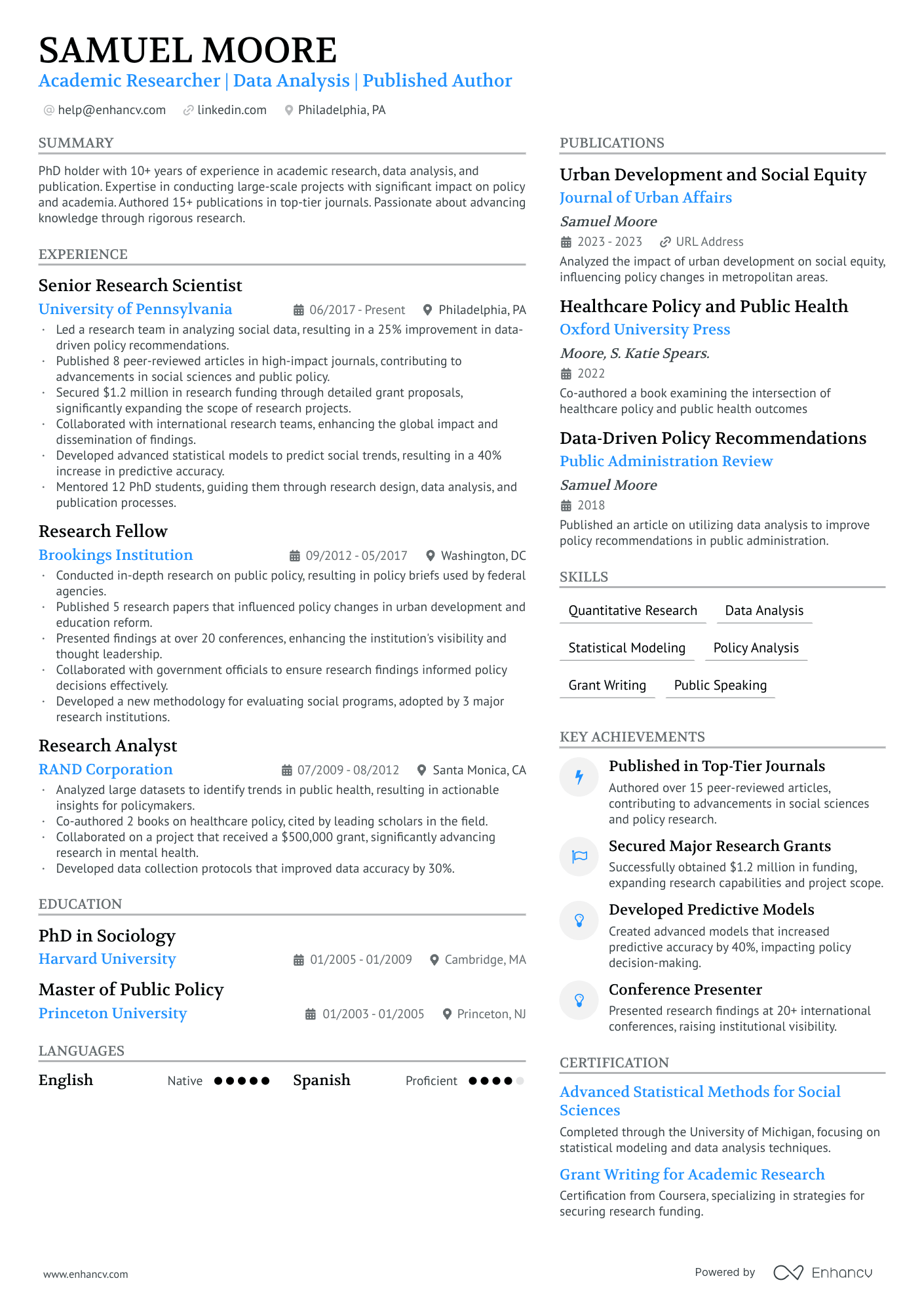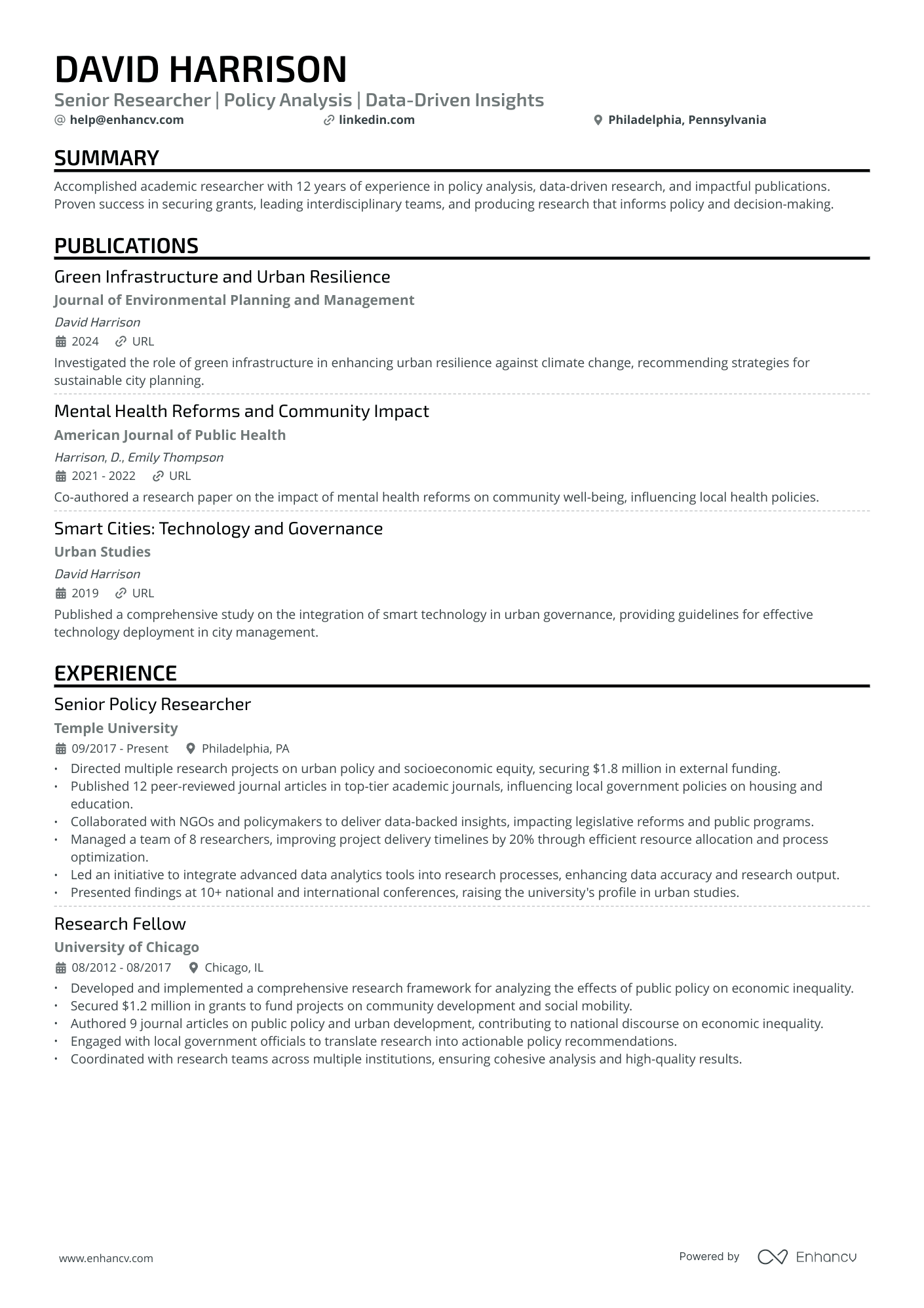You might think a publications section on a resume is reserved solely for those in research or academia. However, it's incredibly beneficial for anyone whose main accomplishments are illustrated through their written work. Whether you're a writer, journalist, therapist, or even a business professional, listing your publications can significantly enhance your resume by underlining your expertise and contributions to your field.
However, crafting an effective publications section can be tricky. How do you decide which pieces to include? How should you format them? And how can you make sure they stand out to hiring managers who might skim past them? Let's break down the main challenges and offer some straightforward solutions to ensure your publications shine on your resume.
Key takeaways:
- The publications section on a resume is particularly relevant for roles in research, academia, journalism, writing, and PhDs across various fields.
- Your published work can include books, papers, and peer-reviewed articles but can also encompass website publications, blog posts, and other non-traditional formats. Tailor your selection based on the specific requirements of your field and role.
- Including publications on a resume enhances your credibility and strengthens your application by underlining your expertise, making it highly valuable in certain professional contexts.
- You can list your publications in a dedicated section (the more common approach) or integrate them into the education section of your resume.
- Maintain a consistent citation style throughout your publications list to ensure professionalism and clarity.
- Avoid common pitfalls, such as providing excessive detail or listing publications that aren’t relevant.
What are publications?
Publications, also called academic publishing, distribute academic research and scholarship. Most of this work is published in academic journal articles, books, or thesis forms. Most scientific and scholarly journals, and many academic and scholarly books, though not all, are based on some form of peer review or editorial refereeing to qualify texts for publication.
Consider including a publications section on your resume if you’re pursuing research-intensive or academic roles. It’s also a good idea to place such a section if writing is an integral part of your work, as publications can give greater credibility to your application.
What counts as a peer-reviewed publication?
A peer-reviewed publication is also sometimes referred to as a scholarly publication. Peer-reviewed publications are articles, scholarly works, research, or ideas written by experts and reviewed by several other experts in the field before being published in a journal to ensure their quality.
Do blog posts count as publications?
Avoid listing blog posts published in magazines or nonscientific publications. If your thesis wasn’t published in a journal, better list it in the “Education” section of your resume/CV.
Do website articles count as a publication?
Including website articles, even if they’re not peer-reviewed, is a great way for a marketer or a copywriter to show their expertise and writing aptness.
However, when you’re applying to a strictly academic position, be cautious only to include publications and articles from industry journal publications and trade association websites.
Why include publications on a resume?
Including publications on a resume is usually done for three main reasons:
- It’s relevant to the job.
- Demonstrates proficiency and authority.
- Employers value publications as a sign of expertise and research skills.
Let’s briefly review each of these options.
Relevance to the job/field
Who benefits from listing publications on their resume the most?
- Research positions: In industries like biotech, pharmaceuticals, environmental science, and engineering—research publications can set candidates apart by showing their ability to conduct and report on critical investigations.
- Academic positions: For roles in academia, including professorships, researcher roles, and even postgraduate admissions—publications are often a requirement rather than a bonus. They demonstrate your contribution to the field and your ongoing engagement with cutting-edge research.
- Content writing, copywriting, journalism: Publications in reputable magazines, journals, or online platforms can be particularly beneficial for professionals in these fields. They underline your ability to engage audiences, craft compelling narratives, and maintain a high standard of language and content quality.
Demonstrating expertise and authority
This might be self-explanatory, but publications in well-regarded outlets are a testament to your writing skills and ability to appeal to broad or specific audiences.
Contributing to major industry publications or influential blogs can also cement your status as an expert in a particular niche or subject area. Including descriptions of the content, target audience, and any notable feedback or outcomes (like awards or recognitions) can emphasize the impact and reach of your work.
Significance to employers
Your publications reflect active participation in industry discussions, networking within media circles, and your potential to influence through written work. They also demonstrate your ability to produce engaging, well-researched content, crucial for roles in media and communications.
How to list publications
In this section, we’ll guide you on how to format your publications effectively, with easy-to-follow examples and tips to make sure your achievements stand out clearly and professionally. Use these general tips to ease your process:
- Title the section appropriately: Use a clear, professional title for the section such as “Publications,” “Research Publications,” or “Selected Publications” if you choose to list only the most relevant or prestigious ones.
- Format consistently: List each publication in a consistent format. Choosing the right citation style for your resume’s publication list is important, as there’s no one-size-fits-all format. Different academic fields and institutions have their own specific rules.
- Categorize if necessary: If you have a large number of publications, consider subdividing them into categories such as “Journal Articles,” “Conference Proceedings,” and “Books” to enhance readability and organization.
- Emphasize key publications: If certain publications are highly relevant to the job you're applying for, consider highlighting them by placing them at the top of the list or providing a brief explanation of why they’re relevant.
Citation styles
Here are examples of the most common citation styles:
The most common citation styles are:
- APA (American Psychological Association)—used by Education, Psychology, and Sciences.
- MLA (Modern Language Association)—used by the Humanities.
- Chicago—generally used by Business, History, and the Fine Arts.
APA format example
The APA format typically includes the author’s last and first names, publication year, article title, volume and issue number, page range, and DOI (if available).
Doe, J. (2023). Understanding Citation Styles. Journal of Academic Resources, 15(4), 123-135. https://doi.org/xx.xxx/yyyy
MLA format example
The MLA format generally requires the author's name, article title, journal title, volume and issue number, publication year, page range, and URL or DOI.
Doe, John. “Understanding Citation Styles.” Journal of Academic Resources, vol. 15, no. 4, 2023, pp. 123-135, www.journalwebsite.com/fullarticle.
Chicago format example
Chicago style can be presented in a note and a bibliographic entry, focusing on the author's name, article title, journal title, volume, issue, year of publication, page range, and accessed URL or DOI.
Doe, John. 2023. “Understanding Citation Styles.” Journal of Academic Resources 15, no. 4 (April): 123-135. https://doi.org/xx.xxx/yyyy.
Note that different academic institutions might have their own stylistic requirements.
How to list publications on an academic CV
Crafting an academic resume or CV that effectively displays your scholarly achievements is crucial, especially when focusing on your publications. This element of your CV not only reflects your research capabilities but also your impact within your field.
Here’s how to structure your publications section efficiently:
- Categorization: Organize your publications into relevant sections such as journal articles, conference papers, books, and book chapters to enhance navigability and emphasis on specific types of work.
- Detail and consistency: Use a consistent citation format appropriate for your discipline. Include all authors, publication year, titles, and publication details. Consider bolding your name to highlight your contributions to collaborative works.
- Chronological order: List your publications in reverse chronological order to immediately draw attention to your most recent scholarly work.
- Descriptors: For key publications, include a brief note on the significance or impact of the work, such as any awards won or significant citations it has garnered.
Is your resume good enough?
Drop your resume here or choose a file. PDF & DOCX only. Max 2MB file size.
Where to list publications on a resume
When deciding where to list publications on a resume, it's important to consider how they align with your overall professional profile and the specific job you’re applying for.
Here’s a deeper look into the most common approaches.
Listing your publications in a separate section
This might be the best approach to give your publications the importance they deserve. It’s especially helpful if you’ve got numerous or particularly prestigious publications you want to draw recruiters’ attention to.
Here’s an example publications section created with the Enhancv resume builder:
This entry emphasizes key publications, following consistent formatting. It’s titled appropriately and includes all the relevant information for potential employers.
Listing your publications in the education section
Incorporating publications into the education section can be effective if you have only a few publications, if your work’s not been peer-reviewed, or if publications aren’t the main focus of your work.
Here’s how to integrate them:
- •Thesis on 'Innovative Strategies in Digital Marketing'—explored the impact of digital platforms on consumer behavior.
- •Published 'The Role of Analytics in Strategic Decision-Making' in Business Horizons, 2001
When adding publications to the education section of a resume for roles like business consulting, it’s key to select ones that are relevant to the job. Calling attention to these publications can enhance a candidate's profile by demonstrating their knowledge and thought leadership.
The publications should complement, not overshadow, the educational details, subtly boosting the candidate's expertise and credibility.
Common mistakes to avoid
Here are some common mistakes to avoid in the publications section of a resume:
- Lack of detail: Simply listing the title of your publication without context or details can be confusing for the reader. Include relevant information such as co-authors, the date of publication, and the name of the journal or conference.
- Overwhelming information: While it’s important to provide details, too much information can overwhelm the reader. Avoid including every single publication if you have many. Instead, select the most relevant or prestigious publications.
- Inconsistent formatting: Consistency in formatting is key. Choose a citation style and use it across all entries. This makes your list easier to read and more professional.
- Not prioritizing: Place your most impressive or relevant publications at the top. If you’re applying for a research position, highlight your peer-reviewed papers over articles or presentations.
- Inaccuracies: Double-check for any inaccuracies in your citations. Incorrect information can be seen as a lack of attention to detail and can question your credibility.
- Ignoring authorship order: Especially in fields where the order of authors is significant, mention your specific role or contribution if it adds value to your application and isn't clear from the author list.
- Neglecting to link to publications: If applicable, provide URLs or DOIs for your publications. This allows employers or committee members to easily access and review your work.
- Omitting publications under review: If you have significant works under review or in the press, consider including these to show ongoing research activity. Mark these as “under review” or “in press.”
- Forgetting non-traditional publications: If relevant, include non-traditional publications such as blogs, industry articles, or major presentations. These can demonstrate expertise and communication skills.
- Using technical jargon: If applying outside of academia or your specific field, minimize technical jargon in your descriptions. Make it accessible to non-specialists who might read your resume.
Faqs about publications on a resume
How should I list confidential publications?
When you've worked on confidential projects, you might struggle with how to list these publications on your resume without revealing sensitive information. One strategy is to use generalized descriptions that focus on the type of research and the skills you employed without detailing the confidential aspects.
For instance, you might list a publication as “Article on proprietary algorithm optimization for a leading fintech company.” This way you get to show your expertise while respecting confidentiality agreements.
How many publications to list?
The number of publications to include on your resume should be guided by their relevance to the job you’re applying for and the space available on your resume. If space is limited, prioritize newer publications that are most relevant to the position. It's generally better to list fewer, more relevant publications than to fill your resume with everything you've done.
Highlight publications that have had a significant impact or are prestigious within your field. Select works that underscore your depth of knowledge, research skills, and any notable collaborations. This selective approach directs the employer’s attention to your most impressive achievements.
How to list pending publications on a resume?
It's acceptable to list works that are under review or forthcoming as long as they’re marked as such. You can list these publications under a separate subheading titled “Forthcoming Publications” or “Manuscripts Under Review,” and include expected publication dates if available. Or, you could simply add an expected publication date in brackets when listing the publication in your respective “Publications” section. This demonstrates your ongoing commitment to your field and keeps your resume current.
Can I put a manuscript in preparation on my resume?
Yes, manuscripts in preparation can be listed to show forthcoming work and ongoing research activities. Label them clearly as “in preparation” to set proper expectations regarding their status.
How to include a digital portfolio on a resume?
Including links to your digital portfolio, personal website, or academic profiles like Google Scholar and ResearchGate can enhance your resume. These links provide direct access to your body of work and can be particularly useful for roles that value research and publications.
An interesting way to link directly to your publications or professional profiles is through QR codes or URLs. This makes it easier for employers to access your work. Ensure that these links are short, readable, and professional.
How to handle older publications?
When considering whether to include older publications, assess their relevance to the position you're applying for. If they demonstrate longstanding expertise or were particularly influential, they might be worth including.
Consider creating an appendix or a separate document where these can be archived. This way, they’re still accessible to those who are interested without cluttering your main resume.
Does a review count as a publication?
Reviews can be included as publications on your resume, especially if they’re peer-reviewed or published in reputable journals. They demonstrate your depth of knowledge and ability to critically engage with your field.
What is the difference between a resume and a CV?
The main differences between a resume and a CV (Curriculum Vitae) are length, purpose, and content. A resume is generally a one-page summary tailored to specific job roles, emphasizing relevant skills and experiences, making it suitable for most job applications in the U.S. and Canada.
A CV, however, is more detailed and without page restrictions, covering one’s entire academic and professional history, including teaching and research experience, publications, and awards, typically required for academic, research, or scientific positions, or jobs in certain countries outside North America.
Conclusion
Listing publications on your resume is more than a mere catalog of your work–it's a strategic display of your professional journey and intellectual contributions. By carefully selecting relevant pieces, maintaining a clear format, and adapting to the specific expectations of your field, you can turn this section into a powerful testament to your expertise and a standout feature in your job applications.
Make one that's truly you.






